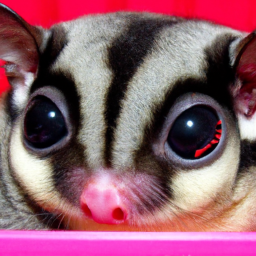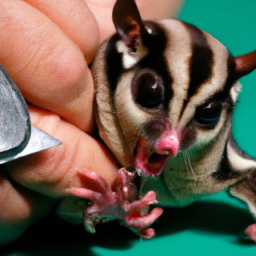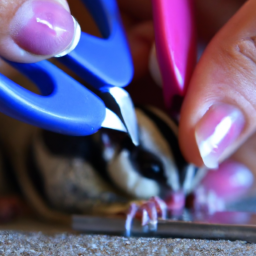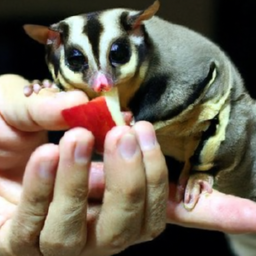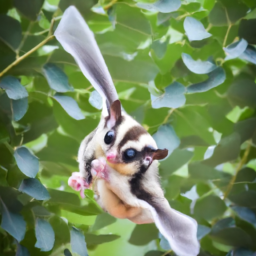How To Treat Sugar Glider Eye Infection
Hey there! Interested in learning how to treat a sugar glider eye infection? Well, you’ve come to the right place! In this article, we’ll provide you with some helpful tips and advice on how to effectively treat a sugar glider eye infection.
If you’re a sugar glider owner, it’s important to be aware of the signs and symptoms of an eye infection in these adorable little creatures. From redness and discharge to swelling and excessive blinking, there are various indicators that your sugar glider may be suffering from an eye infection. However, don’t worry! In our article, we’ll not only explain how these infections can occur but also provide you with practical steps on how to treat them. So, stay tuned and get ready to learn more about how to keep your sugar glider’s eyes healthy and infection-free!
How To Treat Sugar Glider Eye Infection
Owning a sugar glider comes with great responsibilities, one of which is ensuring the well-being and health of these adorable creatures. Sugar gliders, like other pets, can suffer from various health issues, including eye infections. It is essential to understand the causes, symptoms, and treatment options to provide the best care for your sugar glider’s eye infection.
What causes sugar glider eye infections?
Sugar glider eye infections can occur due to various factors, including bacteria, viruses, injuries, or foreign objects entering the eye. These infections can be highly uncomfortable for your pet and may cause swelling, redness, discharge, and difficulty in opening their eyes. It is crucial to identify the underlying cause of the infection to effectively treat it.
Common symptoms of sugar glider eye infections
Identifying the symptoms of a sugar glider eye infection is the first step in diagnosing and treating the condition. Some common symptoms to look out for include:
- Redness and swelling around the eye area
- Excessive tearing or discharge from the eyes
- Squinting or closing the eyes frequently
- Cloudiness or haze over the eyes
- Rubbing or pawing at the affected eye
If you notice any of these symptoms in your sugar glider, it is vital to consult with a veterinarian to determine the best course of action.
Diagnosing Sugar Glider Eye Infections
The importance of a veterinarian
When it comes to eye infections, seeking professional help from a veterinarian is crucial. An experienced veterinarian will have the expertise to diagnose the condition accurately and prescribe appropriate treatment. They can also rule out any underlying health issues that may have contributed to the eye infection.
Diagnostic tests for sugar glider eye infections
To determine the cause and severity of the eye infection, a veterinarian may perform various diagnostic tests. These tests may include a thorough examination of the affected eye, swabs to identify the type of bacteria or virus causing the infection, or even X-rays to rule out any foreign objects or injuries. These tests will enable the veterinarian to tailor the treatment plan specifically to your sugar glider’s needs.
Treating Sugar Glider Eye Infections
Administering prescribed medications
Treatment for sugar glider eye infections often involves antibiotic eye drops or ointments to combat the infection. It is essential to follow the veterinarian’s instructions carefully when administering medications. Be sure to clean the affected area gently with a saline solution before applying the prescribed medication to ensure optimal effectiveness.
Home remedies for sugar glider eye infections
While professional veterinary care is essential for treating sugar glider eye infections, there are some home remedies you can try to alleviate discomfort and promote healing. These include using a warm, damp cloth to gently wipe away any discharge from the eyes and ensuring a clean and hygienic environment for your sugar glider. However, it is crucial to consult with your veterinarian before attempting any home remedies to avoid any potential harm to your pet.
Preventing Sugar Glider Eye Infections
Maintaining a clean and hygienic habitat
Prevention is always better than cure, especially when it comes to eye infections. Keeping your sugar glider’s habitat clean and hygienic is essential to minimize the risk of eye infections. Regularly clean their cage, toys, and accessories, ensuring that there are no sharp edges or objects that can injure their eyes. Additionally, avoiding exposure to excessive dust or irritants can help prevent eye infections.
Proper nutrition and dietary considerations
A well-balanced diet is crucial for maintaining your sugar glider’s overall health and preventing eye infections. Ensure they receive a diet rich in vitamins, minerals, and antioxidants. Incorporating fruits, vegetables, and appropriate commercial sugar glider food will help boost their immune system, making them less susceptible to infections. Consult with a veterinarian or an experienced sugar glider owner for guidance on the best diet plan for your pet.
Incorporating Good Health Practices
Regular check-ups and vet visits
Regular veterinary check-ups are essential to monitor your sugar glider’s overall health and detect any potential issues at an early stage. During these visits, the veterinarian can examine your pet’s eyes and identify any signs of infection or other underlying problems. Timely intervention can help prevent the infection from progressing and causing further damage.
Vaccinations and immunizations for sugar gliders
While there are currently no specific vaccinations available for sugar gliders, it is essential to stay updated on the latest recommendations from veterinarians. Some vaccines aimed at preventing other illnesses in small mammals may indirectly contribute to protecting against certain infections. Consult with your veterinarian to determine if any preventive measures are appropriate for your sugar glider.
Addressing Complications and Atypical Cases
When to seek additional veterinary care
In some cases, sugar glider eye infections can be severe and may require specialized care. If your sugar glider’s condition does not improve or worsens despite treatment, it is essential to seek additional veterinary care. A specialist can provide advanced treatments, such as surgical intervention, if necessary, to aid in your sugar glider’s recovery.
Handling rare or severe sugar glider eye infections
Rare or severe cases of sugar glider eye infections may require more extensive treatment. It is crucial to follow the veterinarian’s recommendations and guidelines when dealing with such cases. These treatments may involve the use of stronger medications, intensive nursing care, or even referral to an ophthalmologist who specializes in animal eye health.
Supporting Your Sugar Glider’s Recovery
Creating a comfortable environment
During their recovery, it is crucial to provide a comfortable and stress-free environment for your sugar glider. Ensure that their cage is clean, well-ventilated, and free from any potential irritants. Minimize handling and provide a quiet space where they can rest and heal peacefully.
Monitoring progress and follow-up care
Keep a close eye on your sugar glider’s progress throughout the treatment process. Monitor their behavior, appetite, and the condition of their eyes regularly. If you notice any changes or worsening of symptoms, contact your veterinarian for further guidance. Follow any recommended follow-up visits to ensure the infection is completely resolved.
Educating Yourself About Sugar Gliders
Understanding sugar gliders’ natural behavior
Taking the time to educate yourself about sugar gliders’ natural behavior and characteristics can help you better understand their needs and address potential health issues promptly. Research reputable sources, consult with experienced sugar glider owners, and join online communities dedicated to sugar glider care to expand your knowledge and ensure the well-being of your pet.
Proper handling and care techniques
Improper handling and care can contribute to eye infections and other health problems in sugar gliders. Learn the proper techniques for handling and providing care for your pet, including trimming their nails regularly, maintaining a suitable temperature and humidity in their habitat, and proper hygiene practices. This knowledge will help minimize the risk of eye infections and promote overall good health.
Raising Awareness and Socializing
Educating others about sugar glider eye infections
As a responsible sugar glider owner, it is important to raise awareness about the potential risks of eye infections in these unique pets. Share your knowledge with fellow owners, friends, and family members to help prevent and address eye infections effectively. This awareness can contribute to better overall health for sugar gliders in the community.
Building a supportive sugar glider community
Being part of a supportive sugar glider community can provide valuable resources, guidance, and emotional support. Join online forums, social media groups, or attend local sugar glider events to connect with other owners. Sharing experiences and knowledge with like-minded individuals can help you become a better owner and advocate for the well-being of these fascinating creatures.
Can an Eye Infection in a Sugar Glider Lead to Rabies?
Eye infections in sugar gliders do not directly lead to a rabies risk with sugar gliders. Rabies is transmitted through the saliva of infected animals, typically through bites. However, any abnormal behavior or symptoms should be addressed by a veterinarian to ensure the overall health and safety of the sugar glider.
If My Sugar Glider Has Rabies, Can It Cause an Eye Infection?
Rabies risk in sugar gliders is a serious concern. If your sugar glider has rabies, it can indeed cause an eye infection. It is crucial to seek immediate veterinary care if you suspect rabies in your pet. Taking precautions and seeking treatment promptly is the best course of action.
Conclusion
Caring for a sugar glider includes providing proper treatment for eye infections and taking preventative measures to ensure their well-being. By understanding the causes, symptoms, and treatment options for sugar glider eye infections, you can promptly address any issues that may arise. Remember to seek professional veterinary care, maintain a clean habitat, practice good health habits, and support your sugar glider’s recovery. With your attention and care, your sugar glider can enjoy a healthy and happy life.
